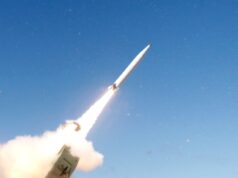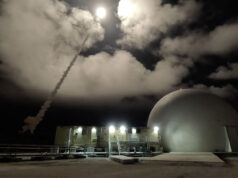Forty-five unmanned aerial vehicles and drones ‘fell out of the sky’ during a US Army exercise after Raytheon’s fantastically named advanced high-power microwave and laser dune buggy engaged and destroyed them.
These threats were knocked down during a Manoeuvre Fires Integrated Experiment at the US Army Fires Center of Excellence.
The event, known as MFIX, brought military and industry leaders together to demonstrate ways to bridge the US Army’s capability gaps in long-range fire and short-range air defence. The results of the exercise, according to Raytheon, were:
- Raytheon’s high-power microwave system engaged multiple UAV swarms, downing 33 drones, two and three at a time.
- Raytheon’s high energy laser, or HEL, system identified, tracked, engaged and killed 12 airborne, maneuvering Class I and II UAVs, and destroyed six stationary mortar projectiles.
“The speed and low cost per engagement of directed energy is revolutionary in protecting our troops against drones,” said Dr. Thomas Bussing, Raytheon Advanced Missile Systems vice president.
“We have spent decades perfecting the high-power microwave system, which may soon give our military a significant advantage against this proliferating threat.”
Raytheon and the US Air Force Research Laboratory worked together under a $2 million contract to test and demonstrate high-power microwave, counter-UAV capabilities.
“Our customer needed a solution, and they needed it fast,” said Dr. Ben Allison, director of Raytheon’s HEL product line.
“So, we took what we’ve learned and combined it with combat-proven components to rapidly deliver a small, self-contained and easily deployed counter-UAV system.”









[…] post US Army exercise sees 45 drones defeated by energy weapons fired from fantastically named ‘las… appeared first on UK Defence […]
I wonder what we have in our arsenal to defeat drones? I wouldn’t mind seeing us jump on any US procurement orders for this as our laser technology development seems years behind, albeit to my uninformed mind.
we are very much on the case i believe, as well as joint ventures with France.
i have to admit, this tech is only as good as the brains behind it all.
in terms of what can be achieved militarily the US have the brains, the budget and the ambition which im in awe of tbh.
Don’t believe for a second we don’t have equally capable brains – budget and ambition are another matter
looks like a star war desert dune buggy, if it works, great.i hope our own dragonfire will be a success.
Class II UAVs include Scan Eagle. There are no details on altitude or range of engagement for obvious reasons.
I am a cynic regarding direct energy weapons but that’s the sort of data that counts. Killing a Scan eagle at 3.5 K feet and a few thousand meters range would be impressive . Killing it at say 500ft and at a range of 500m…not so impressive.
The Devil is in the detail.
All true,
Was this part of a similar demo that they did in Germany recently with a laser weapon?
I only ask because for that demo all engagements needed to be below the horizon so as not to interfere with other air traffic in the area.
Prior to any firing ( Guns or Laser) you NOTAM the area. That lets Aviation and Mariners know to keep clear of the area between certain times and to stay above a certain altitude.
Won’t be long now before all modern weapon systems are redundant and we’ll be back to bows and arrows and close combat. Where’s my animal bone?
Won’t be long now before all modern weapon systems are redundant and we’ll be back to bows and arrows and close combat. Where’s my animal bone?
Sounds impressive, but detail is important. In a real operation, the drones would not be just passively trying to avoid being shot down. Any drones that were armed would be firing back.
What about number 46?
Regarding the “stationary Mortar”, I presume they just suspended a mortar from a cable and fired the laser at it to see if it can penetrate and detonate.
It would be very impressive if they could destroy inbount mortars in flight…… hopefully in time.
Another thing of note is how ubiquitous these “Polaris Defence” ATVs are becoming.
1 liter diesel engined, the military version costs around $40k & can impressively carry up to 6 men and kit.
The US army & marines use them predominantly in support/logistic roles
size and compact, looks adaptable for anything from a jeep to an aircraft carrier,IF, it works against real weapons, tanks e.t.c.
As they become more and more powerful and portable in the field the focus has to be on how useable they actually are. What if it breaks down? Will a unit equipped with one of these have the know-how and tech to actually be able to repair it? What about how durable it is? A laser weapon sounds a lot more fragile than say, an simple and reliable weapon like an AK-47.
If these questions can be answered then lasers as a weapon might well be very useful and the next step in weapon technology.
LED lasers or Fibre Optic lasers are a lot more robust than the old school gas lasers. As with any laser managing the power , heat and atmospherics is the issue when using them in the field
[…] US Army exercise sees 45 drones defeated by energy weapons fired from fantastically named ‘laser buggy’ […]